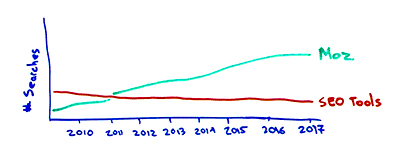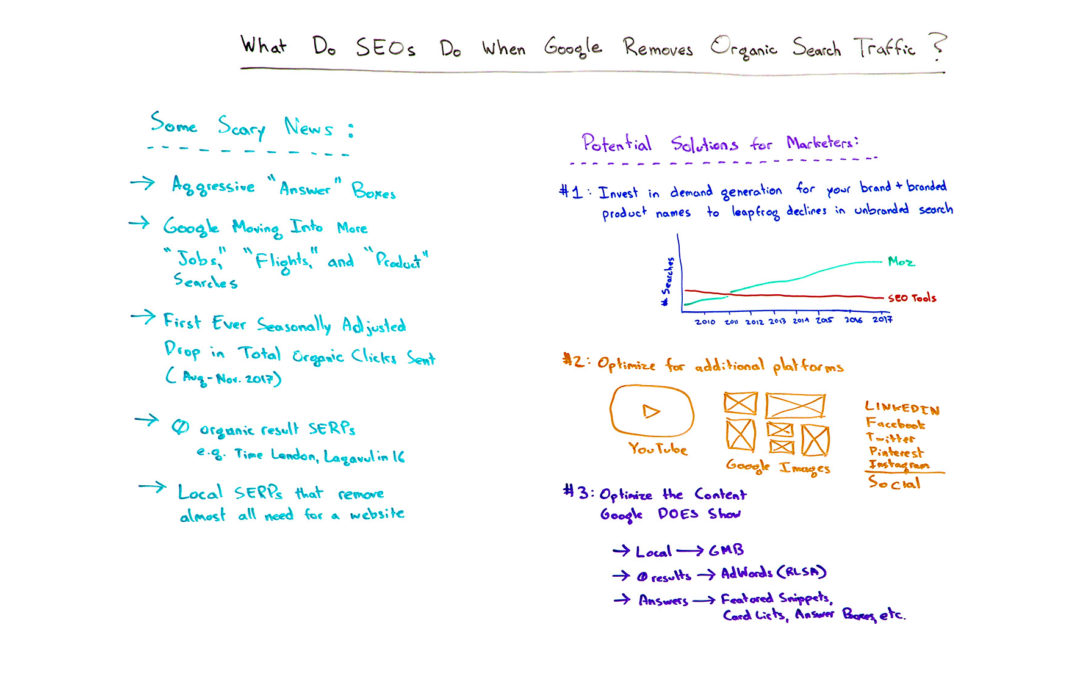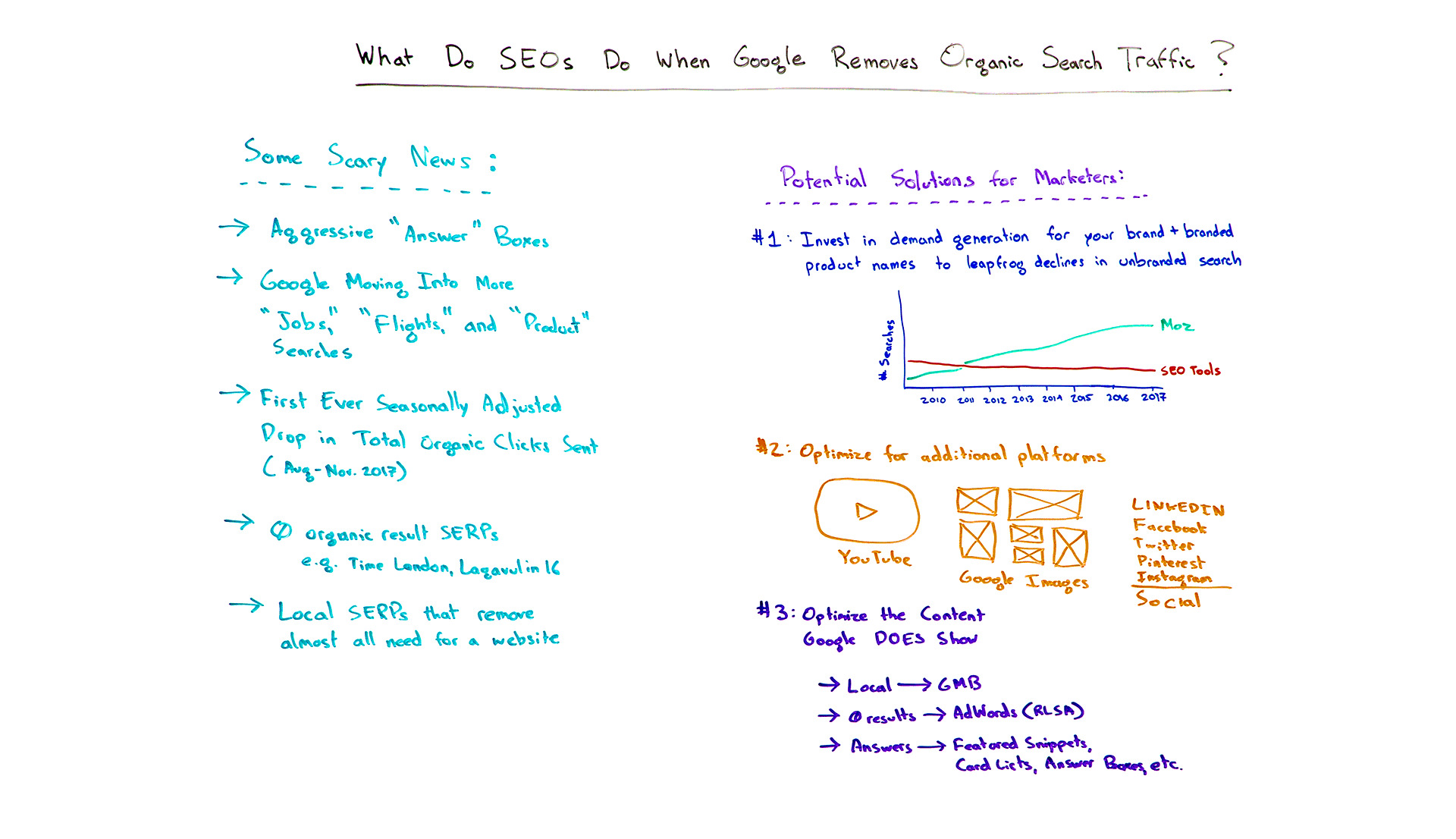Posted by randfish
We rely pretty heavily on Google, but some of their decisions of late have made doing SEO more difficult than it used to be. Which organic opportunities have been taken away, and what are some potential solutions? Rand covers a rather unsettling trend for SEO in this week’s Whiteboard Friday.
Click on the whiteboard image above to open a high-resolution version in a new tab!
Video Transcription
Howdy, Moz fans, and welcome to another edition of Whiteboard Friday. This week we’re talking about something kind of unnerving. What do we, as SEOs, do as Google is removing organic search traffic?
So for the last 19 years or 20 years that Google has been around, every month Google has had, at least seasonally adjusted, not just more searches, but they’ve sent more organic traffic than they did that month last year. So this has been on a steady incline. There’s always been more opportunity in Google search until recently, and that is because of a bunch of moves, not that Google is losing market share, not that they’re receiving fewer searches, but that they are doing things that makes SEO a lot harder.
Some scary news
Things like…
- Aggressive “answer” boxes. So you search for a question, and Google provides not just necessarily a featured snippet, which can earn you a click-through, but a box that truly answers the searcher’s question, that comes directly from Google themselves, or a set of card-style results that provides a list of all the things that the person might be looking for.
- Google is moving into more and more aggressively commercial spaces, like jobs, flights, products, all of these kinds of searches where previously there was opportunity and now there’s a lot less. If you’re Expedia or you’re Travelocity or you’re Hotels.com or you’re Cheapflights and you see what’s going on with flight and hotel searches in particular, Google is essentially saying, “No, no, no. Don’t worry about clicking anything else. We’ve got the answers for you right here.”
- We also saw for the first time a seasonally adjusted drop, a drop in total organic clicks sent. That was between August and November of 2017. It was thanks to the Jumpshot dataset. It happened at least here in the United States. We don’t know if it’s happened in other countries as well. But that’s certainly concerning because that is not something we’ve observed in the past. There were fewer clicks sent than there were previously. That makes us pretty concerned. It didn’t go down very much. It went down a couple of percentage points. There’s still a lot more clicks being sent in 2018 than there were in 2013. So it’s not like we’ve dipped below something, but concerning.
- New zero-result SERPs. We absolutely saw those for the first time. Google rolled them back after rolling them out. But, for example, if you search for the time in London or a Lagavulin 16, Google was showing no results at all, just a little box with the time and then potentially some AdWords ads. So zero organic results, nothing for an SEO to even optimize for in there.
- Local SERPs that remove almost all need for a website. Then local SERPs, which have been getting more and more aggressively tuned so that you never need to click the website, and, in fact, Google has made it harder and harder to find the website in both mobile and desktop versions of local searches. So if you search for Thai restaurant and you try and find the website of the Thai restaurant you’re interested in, as opposed to just information about them in Google’s local pack, that’s frustratingly difficult. They are making those more and more aggressive and putting them more forward in the results.
Potential solutions for marketers
So, as a result, I think search marketers really need to start thinking about: What do we do as Google is taking away this opportunity? How can we continue to compete and provide value for our clients and our companies? I think there are three big sort of paths — I won’t get into the details of the paths — but three big paths that we can pursue.
1. Invest in demand generation for your brand + branded product names to leapfrog declines in unbranded search.

The first one is pretty powerful and pretty awesome, which is investing in demand generation, rather than just demand serving, but demand generation for brand and branded product names. Why does this work? Well, because let’s say, for example, I’m searching for SEO tools. What do I get? I get back a list of results from Google with a bunch of mostly articles saying these are the top SEO tools. In fact, Google has now made a little one box, card-style list result up at the top, the carousel that shows different brands of SEO tools. I don’t think Moz is actually listed in there because I think they’re pulling from the second or the third lists instead of the first one. Whatever the case, frustrating, hard to optimize for. Google could take away demand from it or click-through rate opportunity from it.
But if someone performs a search for Moz, well, guess what? I mean we can nail that sucker. We can definitely rank for that. Google is not going to take away our ability to rank for our own brand name. In fact, Google knows that, in the navigational search sense, they need to provide the website that the person is looking for front and center. So if we can create more demand for Moz than there is for SEO tools, which I think there’s something like 5 or 10 times more demand already for Moz than there is tools, according to Google Trends, that’s a great way to go. You can do the same thing through your content, through your social media, and through your email marketing. Even through search you can search and create demand for your brand rather than unbranded terms.
2. Optimize for additional platforms.

Second thing, optimizing across additional platforms. So we’ve looked and YouTube and Google Images account for about half of the overall volume that goes to Google web search. So between these two platforms, you’ve got a significant amount of additional traffic that you can optimize for. Images has actually gotten less aggressive. Right now they’ve taken away the “view image directly” link so that more people are visiting websites via Google Images. YouTube, obviously, this is a great place to build brand affinity, to build awareness, to create demand, this kind of demand generation to get your content in front of people. So these two are great platforms for that.
There are also significant amounts of web traffic still on the social web — LinkedIn, Facebook, Twitter, Pinterest, Instagram, etc., etc. The list goes on. Those are places where you can optimize, put your content forward, and earn traffic back to your websites.
3. Optimize the content that Google does show.
Local
So if you’re in the local space and you’re saying, “Gosh, Google has really taken away the ability for my website to get the clicks that it used to get from Google local searches,” going into Google My Business and optimizing to provide information such that people who perform that query will be satisfied by Google’s result, yes, they won’t get to your website, but they will still come to your business, because you’ve optimized the content such that Google is showing, through Google My Business, such that those searchers want to engage with you. I think this sometimes gets lost in the SEO battle. We’re trying so hard to earn the click to our site that we’re forgetting that a lot of search experience ends right at the SERP itself, and we can optimize there too.
Results
In the zero-results sets, Google was still willing to show AdWords, which means if we have customer targets, we can use remarketed lists for search advertising (RLSA), or we can run paid ads and still optimize for those. We could also try and claim some of the data that might show up in zero-result SERPs. We don’t yet know what that will be after Google rolls it back out, but we’ll find out in the future.
Answers
For answers, the answers that Google is giving, whether that’s through voice or visually, those can be curated and crafted through featured snippets, through the card lists, and through the answer boxes. We have the opportunity again to influence, if not control, what Google is showing in those places, even when the search ends at the SERP.
All right, everyone, thanks for watching for this edition of Whiteboard Friday. We’ll see you again next week. Take care.
Video transcription by Speechpad.com
Sign up for The Moz Top 10, a semimonthly mailer updating you on the top ten hottest pieces of SEO news, tips, and rad links uncovered by the Moz team. Think of it as your exclusive digest of stuff you don’t have time to hunt down but want to read!
![]()


